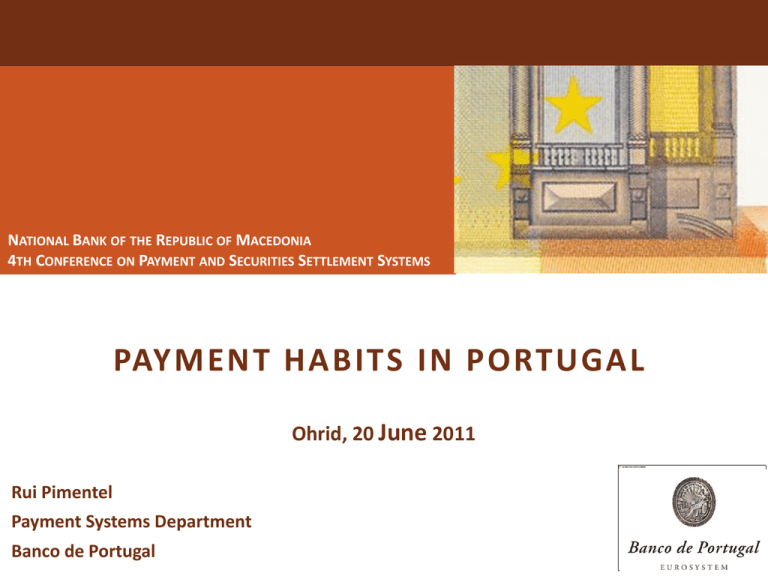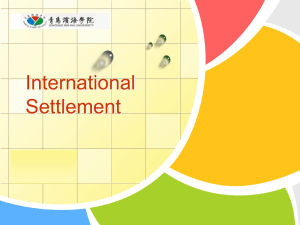Payment Habits in Portugal
advertisement

NATIONAL BANK OF THE REPUBLIC OF MACEDONIA 4TH CONFERENCE ON PAYMENT AND SECURITIES SETTLEMENT SYSTEMS PAYMENT HABITS IN PORTUGAL Ohrid, 20 June 2011 Rui Pimentel Payment Systems Department Banco de Portugal P AY M E N T H A B I T S I N P O R T U G A L A GENDA 1. Retail Payment Systems in Portugal 2. Role of Banco de Portugal 3. SEPA Implementation & Impacts 4. EU Trends vs Payment Habits in Portugal 5. Conclusions 4th Conference on Payment and Securities Settlement Systems 2 P AY M E N T H A B I T S I N P O R T U G A L 1 . R E TA I L P AY M E N T S Y S T E M S IN P ORTUGAL 4th Conference on Payment and Securities Settlement Systems 3 P AY M E N T H A B I T S I N P O R T U G A L 1 . R E TA I L P AY M E N T S Y S T E M S I N P O R T U G A L Portugal – Country profile: Area – 92 345 sq kilometres Population – 10,6 million (2010) GDP per inhabitant – 16 236 € (2010) 4th Conference on Payment and Securities Settlement Systems 4 P AY M E N T H A B I T S I N P O R T U G A L 1 . R E TA I L P AY M E N T S Y S T E M S I N P O R T U G A L The use of retail payment instruments in Portugal is very much based on transactions processed and cleared in SICOI, the national interbank clearing system, owned and regulated by Banco de Portugal, including several subsystems: Cheques Bills of exchange Credit Transfers These include both legacy and SEPA solutions Direct Debits Multibanco transactions 4th Conference on Payment and Securities Settlement Systems 5 P AY M E N T H A B I T S I N P O R T U G A L 2. ROLE OF BANCO DE P ORTUGAL 4th Conference on Payment and Securities Settlement Systems 6 P AY M E N T H A B I T S I N P O R T U G A L 2. ROLE OF BANCO DE P ORTUGAL A member of the Eurosystem, Banco de Portugal acts as national central bank and performs the oversight and the catalyst functions in the Portuguese market regarding the smooth functioning of payment systems (as established in the Organic Law). As a result, it shall be incumbent on Banco de Portugal to ensure the economic agents access to efficient, time-critical and secure payment systems. http://www.bportugal.pt/en-US/SistemasdePagamento/Pages/default.aspx 4th Conference on Payment and Securities Settlement Systems 7 P AY M E N T H A B I T S I N P O R T U G A L 2. ROLE OF BANCO DE P ORTUGAL In the context of retail payments, currently the implementation of SEPA is a relevant project, not only for Banco de Portugal locally but for the Eurosystem as a whole. Monitorisation and fostering of SEPA migration in the Portuguese market have been among the top tasks of Banco de Portugal in the field of retail payments in the last few years. 4th Conference on Payment and Securities Settlement Systems 8 P AY M E N T H A B I T S I N P O R T U G A L 2. ROLE OF BANCO DE P ORTUGAL Governance structure – To foster dialogue with market participants, Banco de Portugal set up two consultative bodies: Payment Systems Interbank Commission (CISP) Payment Systems Forum – includes a dedicated SEPA Steering Committee 4th Conference on Payment and Securities Settlement Systems 9 P AY M E N T H A B I T S I N P O R T U G A L 2. ROLE OF BANCO DE P ORTUGAL The Payment Systems Interbank Commission (CISP) is active since 1997, including a structure of working groups covering all payment instruments in use in the Portuguese market, both at steering committee and technical levels. Chaired by Banco de Portugal, CISP includes representatives at board level from the State Treasury, the Portuguese Banking Association, SIBS (interbank services provider) and the major banks. Co-operative initiatives in this field are discussed at CISP level. 4th Conference on Payment and Securities Settlement Systems 10 P AY M E N T H A B I T S I N P O R T U G A L 2. ROLE OF BANCO DE P ORTUGAL In order to achieve a necessary dialogue on the use and evolution of payment systems involving end-users, the Payment Systems Forum was created in 2009, including a dedicated SEPA Steering Committee. 4th Conference on Payment and Securities Settlement Systems 11 P AY M E N T H A B I T S I N P O R T U G A L 2. ROLE OF BANCO DE P ORTUGAL A number of relevant stakeholders are represented in the Forum, again chaired by Banco de Portugal. Apart from financial institutions and SIBS, it also includes representatives from the most active Public Administration entities as regards the use of retail payment instruments (treausry, social security, tax agency, municipalities), as well as Consumer Organisations and companies that are “Big Billers” (utilities, telcos, energy, water supply, insurance) and the most relevant Retailers. 4th Conference on Payment and Securities Settlement Systems 12 P AY M E N T H A B I T S I N P O R T U G A L 3 . S E PA I M P L E M E N TAT I O N & I M PA C T S 4th Conference on Payment and Securities Settlement Systems 13 P AY M E N T H A B I T S I N P O R T U G A L 3 . S E P A I M P L E M E N TAT I O N & I M PA C T S The implementation of SEPA poses new challenges as a result of its harmonisation goals and greater market integration. Interbank payment operations are mostly national Payment habits are heterogeneous across countries SEPA also brings a new reality for a traditionally bank-dominated domain 4th Conference on Payment and Securities Settlement Systems 14 P AY M E N T H A B I T S I N P O R T U G A L 3 . S E P A I M P L E M E N TAT I O N & I M PA C T S In Portugal, SEPA migration levels are still at relatively low as a result of several factors: Extensive range of services available at the Multibanco network (ATMs & POSs) Cash withdrawals Direct Debits Cheque books request Motorway tolls Enquiries/Statements Bill payments (utilities, taxes, etc) Interbank Credit Transfers PIN change MB Phone (some operations are available on mobile phones) Public transport Tickets Portuguese community AOS – namely in direct debits 4th Conference on Payment and Securities Settlement Systems 15 P AY M E N T H A B I T S I N P O R T U G A L 3 . S E P A I M P L E M E N TAT I O N & I M PA C T S In Portugal, SEPA migration levels are still relatively low as a result of several factors (cont): Migration of Social Security pensions and other payments (2011) Challenges: establishment of end date(s) via EU Regulation; MIF in direct debits; enhance migration levels SCT – 2,6% SDD – residual April 2011 In the field of SEPA communication, Banco de Portugal lauched an institutional video and in January 2011 started to publish a newsletter. 4th Conference on Payment and Securities Settlement Systems 16 P AY M E N T H A B I T S I N P O R T U G A L 3 . S E P A I M P L E M E N TAT I O N & I M PA C T S In the field of cards, a relevant issue for the completion of SEPA is the EMV migration process – an essential step to make card transactions SEPA-compliant Available indicators show progress but there’s still room for improvement 4th Conference on Payment and Securities Settlement Systems 17 P AY M E N T H A B I T S I N P O R T U G A L 3 . S E P A I M P L E M E N TAT I O N & I M PA C T S Source: ECB 4th Conference on Payment and Securities Settlement Systems 18 P AY M E N T H A B I T S I N P O R T U G A L 3 . S E P A I M P L E M E N TAT I O N & I M PA C T S Source: ECB 4th Conference on Payment and Securities Settlement Systems 19 P AY M E N T H A B I T S I N P O R T U G A L 3 . S E P A I M P L E M E N TAT I O N & I M PA C T S Source: ECB 4th Conference on Payment and Securities Settlement Systems 20 P AY M E N T H A B I T S I N P O R T U G A L 3 . S E P A I M P L E M E N TAT I O N & I M PA C T S Source: ECB 4th Conference on Payment and Securities Settlement Systems 21 P AY M E N T H A B I T S I N P O R T U G A L 3 . S E P A I M P L E M E N TAT I O N & I M PA C T S In the case of Portugal, figures for April 2011 show the following migration indicators: ATM – 100% POS – 95% Cards – 84% Towards the year-end, the expectation is to achieve a near-complete migration However, as the cards market has global reach, EMV migration still has challenges to overcome 4th Conference on Payment and Securities Settlement Systems 22 P AY M E N T H A B I T S I N P O R T U G A L 3 . S E P A I M P L E M E N TAT I O N & I M PA C T S The migration process is most significant in Europe with several other countries already moving towards EMV However, in spite of some initiatives, the USA are still lagging behind in this respect (…) Chip and personal identification number (PIN) is old hat on the European side of the pond, but US banks – and consumers - are no closer to upgrading their card infrastructure than they were in 1999, when American Express first tried selling Americans 'Blue' smart cards. (…) Bob Sullivan, EPC Newsletter 28.04.2011 – “The Magnetic Stripe: Why it is Hard for Americans to Say Good-Bye” 4th Conference on Payment and Securities Settlement Systems 23 P AY M E N T H A B I T S I N P O R T U G A L 4. E U TRENDS VS P AY M E N T H A B I T S IN P ORTUGAL 4th Conference on Payment and Securities Settlement Systems 24 P AY M E N T H A B I T S I N P O R T U G A L 4 . E U T R E N D S V S P AY M E N T H A B I T S I N P O R T U G A L In several European countries – including Portugal – studies have been carried out since 2002 by National Central Banks on the costs of the use of payment instruments, namely comparing the cost of using cash, vis à vis the use of electronic instruments. The ECB plans to carry out a similar study with European-wide reach, with a harmonised methodology among countries to allow comparability. This initiative is to be completed on a voluntary basis – Several countries committed to participate. http://www.bportugal.pt/en-US/SistemasdePagamento/Publicacoes1/Tumbnails%20List%20Template/Study%20-%20July%202007.pdf 4th Conference on Payment and Securities Settlement Systems 25 P AY M E N T H A B I T S I N P O R T U G A L 4 . E U T R E N D S V S P AY M E N T H A B I T S I N P O R T U G A L In the study carried out by Banco de Portugal (published in 2007 with 2005 data), conclusions show that the coverage rate of the total revenues generated by payment instruments is only of 63.4% of the total costs. Coverage rate Total revenues 722,0 M€ 63,4% Total costs 1.138,7 M€ This leads to the conclusion that there is cross-subsidisation of the use of payment instruments by other banking products. 4th Conference on Payment and Securities Settlement Systems 26 P AY M E N T H A B I T S I N P O R T U G A L 4 . E U T R E N D S V S P AY M E N T H A B I T S I N P O R T U G A L When comparing in more detail the unit costs and revenues for all payment instruments considered – from the banks’ perspective –, there are significant differences between them, where cash is clearly the one with a worse coverage rate (i.e. the least efficient in this respect), as opposed to credit cards and direct debits (the most efficient ones – higher revenues vs costs per transaction). 4.3% Unit cost Unit revenue 39.4% Cash Cheques 1,85 € 0,08 € 1,45 € 0,57 € 81.5% 92.7% 107.5% DebitCards Credit Transfers Credit Cards 0,23 € 0,18 € 0,28 € 0,26 € 2,44 € 2,62 € 4th Conference on Payment and Securities Settlement Systems 159.5% Direct Debits 0,09 € 0,15 € 27 P AY M E N T H A B I T S I N P O R T U G A L 4 . E U T R E N D S V S P AY M E N T H A B I T S I N P O R T U G A L The use of cashless payment instruments in Portugal has been steadily growing in the last few years, whereas the number of cheques issued has seen a sharp reduction. In the context of the EU as a whole, country profiles vary considerably regarding the use of payment instruments, as shown from data published by the ECB (figures for 2010 not yet available). 400 N. of payments Number of cashless payments per capita, 2009 350 300 250 200 150 100 50 0 FI SE NL LU 100% DK AT GB FR BE DE EE IE SI PT ES CY LV Structure of cashless payments, 2009 (%) Cheques Credit transfers HU SK Direct debits MT LT IT PL CZ GR RO BG PL CZ GR RO BG Card payments 80% 60% 40% 20% 0% FI SE NL LU DK AT Cheques GB FR BE DE EE Direct debits IE SI PT ES CY Credit transfers LV HU SK MT LT IT Card payments Source: Blue Book (ECB, Statistical Data Warehouse) 4th Conference on Payment and Securities Settlement Systems 28 P AY M E N T H A B I T S I N P O R T U G A L 4 . E U T R E N D S V S P AY M E N T H A B I T S I N P O R T U G A L Regarding the use of cards in the context of the EU, recent data collected by the ECB shows that the number of cash withdrawals at ATMs has consistently been substituted by payment transactions at the point-of-sale through the last 10 years (figures for 2010 not yet available). This is particularly true in the nordic countries. N. of withdrawals 80 Number of ATM withdrawals, per card 70 60 50 40 30 20 10 0 N. of payments AT BE BG 160 2000 CY CZ DE 2001 DK CZ DE 2001 DK EE 2002 ES FI FR GB GR HU IE IT LT LU LV MT NL PL 2007 PT RO 2008 SE SI SK 2009 MT NL PL 2007 PT RO 2008 SE SI SK 2009 2003 2005 Number of 2004 payments, per card2006 140 120 100 80 60 40 20 0 AT BE BG 2000 CY EE 2002 ES FI FR 2003 GB GR HU 2004 IE IT 2005 LT LU LV 2006 Source: Blue Book (ECB, Statistical Data Warehouse) 4th Conference on Payment and Securities Settlement Systems 29 P AY M E N T H A B I T S I N P O R T U G A L 4 . E U T R E N D S V S P AY M E N T H A B I T S I N P O R T U G A L Regarding the Portuguese case, the trend in the last 20 years has been of a significant growth in the use of electronic payments, in particular the use of cards, while credit transfers and direct debits also became more widely used during this period (figures for 2010 not yet available). A 140-fold growth 4th Conference on Payment and Securities Settlement Systems 30 P AY M E N T H A B I T S I N P O R T U G A L 4 . E U T R E N D S V S P AY M E N T H A B I T S I N P O R T U G A L Given the wide variety of available transactions in the Multibanco network, Portugal’s country profile concerning the usage of payment cards – for transactions with financial impact – is currently the following (2010 data): Source: Banco de Portugal statistics 4th Conference on Payment and Securities Settlement Systems 31 P AY M E N T H A B I T S I N P O R T U G A L 4 . E U T R E N D S V S P AY M E N T H A B I T S I N P O R T U G A L In parallel with the growth in the use of cards, also credit transfers have gained relevance in the context of the use of cashless payment instruments in Portugal since 2000, with a noticeable and steady growth not only in total volumes but also with diversified types of transactions: N. of credit transfers (thousands) Volume of credit transfers in Portugal - by type of transaction Source: Banco de Portugal statistics 25000 20000 15000 10000 5000 0 2000 2001 2002 National - Housing rents National - Social security payments Cross-border 2003 2004 2005 National - Wages National - Pensions 2006 2007 2008 2009 2010 National - Suppliers National - State reimbursements 4th Conference on Payment and Securities Settlement Systems 32 P AY M E N T H A B I T S I N P O R T U G A L 5 . C ONCLUSIONS 4th Conference on Payment and Securities Settlement Systems 33 P AY M E N T H A B I T S I N P O R T U G A L 5 . C ONCLUSIONS In the changing landscape of retail payments in Europe, several challenges lie ahead and Portugal is no exception Further market integration will be achieved in the medium term, with the full implementation of SEPA, eliminating fragmented, national-only, payment solutions & schemes In this context, all transactions in euro will become “domestic”, after national solutions/schemes are phased out 4th Conference on Payment and Securities Settlement Systems 34 P AY M E N T H A B I T S I N P O R T U G A L 5 . C ONCLUSIONS Security issues – Fraud prevention on remote payments Regulatory issues – New entrants can now have access to a traditional field of banking services: Payment Institutions New channels & innovative products will emerge: mobile & contactless payment solutions, e-payments linked to einvoicing New payment habits for end users 4th Conference on Payment and Securities Settlement Systems 35 P AY M E N T H A B I T S I N P O R T U G A L QUESTIONS 4th Conference on Payment and Securities Settlement Systems 36 P AY M E N T H A B I T S I N P O R T U G A L THANK YOU RUI PIMENTEL Head of the Payment Systems Analysis and Development Unit Payment Systems Department Banco de Portugal +351.21.3130944 rpimentel@bportugal.pt 4th Conference on Payment and Securities Settlement Systems 37





